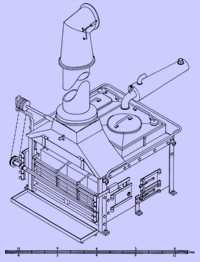


 A Home Glossary C
A Home Glossary C
Revised May 27 2021

| Number of bells | Bell pattern | Middle watch | Morning watch | Forenoon watch | Afternoon watch | First dog watch | Last dog watch | First watch |
|---|---|---|---|---|---|---|---|---|
| One bell | . | 0:30 | 4:30 | 8:30 | 12:30 | 16:30 | 20:30 | |
| Two bells | .. | 1:00 | 5:00 | 9:00 | 13:00 | 17:00 | 21:00 | |
| Three bells | .. . | 1:30 | 5:30 | 9:30 | 13:30 | 17:30 | 21:30 | |
| Four bells | .. .. | 2:00 | 6:00 | 10:00 | 14:00 | 18:00 | 22:00 | |
| Five bells | .. .. . | 2:30 | 6:30 | 10:30 | 14:30 | 18:30 | 22:30 | |
| Six bells | .. .. .. | 3:00 | 7:00 | 11:00 | 15:00 | 19:00 | 23:00 | |
| Seven bells | .. .. .. . | 3:30 | 7:30 | 11:30 | 15:30 | 19:30 | 23:30 | |
| Eight bells | .. .. .. .. | 4:00 | 8:00 | 12:00 | 16:00 | 20:00 | 0:00 |
At midnight on New Year's Eve sixteen bells would be struck - eight bells for the old year and eight bells for the new.
Most of the crew of a ship would be divided up into between two and four groups called watches. Each watch would take its turn with the essential activities of manning the helm, navigating, trimming sails, and keeping a lookout.
The hours between 16:00 and 20:00 are so arranged because that watch (the 'dog watch') was divided into two. The odd number of watches aimed to give each man a different watch each day. It also allows the entire crew of a vessel to eat an evening meal, the normal time being at 1700 with First Dog watchmen eating at 1800.

 Scotsman Alexander Brodie patented this stove in 1781 and it was used by the Royal Navy until 1810.
The Brodie stove was used not only to prepare food, but to warm and dry the ship. When the logs say
"fires were kept in all night," this is where they were kept. The scale at the bottom of the image
is twelve feet, but of course the stoves were made in various sizes depending on the size of the
ship. On the Bounty, the stove was in the
forecastle, directly under the stovepipe.
(Click image to see original.)
Scotsman Alexander Brodie patented this stove in 1781 and it was used by the Royal Navy until 1810.
The Brodie stove was used not only to prepare food, but to warm and dry the ship. When the logs say
"fires were kept in all night," this is where they were kept. The scale at the bottom of the image
is twelve feet, but of course the stoves were made in various sizes depending on the size of the
ship. On the Bounty, the stove was in the
forecastle, directly under the stovepipe.
(Click image to see original.)
See table at puncheon
 A Home Glossary C
A Home Glossary C